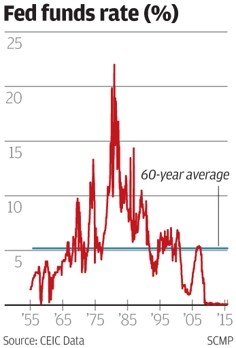
Crystal ball forecasts further Fed dithering in 2016
The vaunted recovery on which expectations of a return to normalcy rest looks decidedly anaemic
Fed rate rise turns up heat on HK banks
Business headline, December 16
Well, if our headline writers are allowed to assume that the US Federal Reserve will raise interest rates, why can’t I?
I think it a relatively safe forecast that the decision, made by the time you read this, will have been for a 25 basis point increase in the fed funds rate. I also think it obvious that US monetary policy will continue to be one of the key driving forces of financial markets in 2016.
Thus it is time to announce the readings of my crystal ball for next year, particularly as I like to reserve the last two weeks of the year for hill-walking, feasting and Christmas laziness, which means this is my last column for 2015. I think US interest rates are going nowhere.
For perspective, the chart shows you the 60-year history of the fed funds rate, 0.08 per cent at present. The straight line across the chart shows you the average of that period. 5.19 per cent, which we shall define as normalcy, a target to which the Fed faithful say we are returning.

Look at it another way. The US government’s 10-year treasury note at present yields 2.23 per cent. The 60-year average is 6.15 per cent. On US$18.8 trillion of federal government debt, the difference in annual interest payments would be about US$730 billion, bringing the total interest burden to just under US$1 trillion a year, a third of total revenues.
Even on planet Zorg politicians would never countenance starving all their favourite programmes for such an outlay. On Earth it might mean that the US could start no more wars in the Middle East. Inconceivable.
The vaunted recovery on which expectations of a return to normalcy rest also looks decidedly anaemic. The Fed, we are told, is cheered by data showing a strong recovery in jobs with 121.89 million people in full time work last month. Exactly eight years ago that figure was 121.04 million. Recovery?
Payment for the Fed folly of the past 20 years must eventually still be made, possibly in another financial crisis
The real difference over these eight years is that decent paying jobs are way down and low-paying insecure “gigs” in menial services are way up.
So it goes across the entire US economy. The zero interest rate policy of the past eight years has created froth in financial markets but done little to strengthen real industry. In fact the Fed has weakened it by creating a cheap debt culture.
Thus here is my prediction. The Fed will administer that 25 basis points and then dither, dally, dawdle and delay about administering another, but finally get up enough courage to do it.
The banker chorus in New York will then scream out, “Hey! Watch it! Whaddya think you’re doing? Get with the show!”
And the Fed will promptly get with the show. That will be the end of the return to normalcy. Payment for the Fed folly of the past 20 years must eventually still be made, possibly in another financial crisis, but I think 2016 for the US will be a go-nowhere, do-nothing year.
In Hong Kong, however, where banks are glorified pawn shops, where the six-month mortgage delinquency ratio in the last big crash never even topped 1 per cent, and where home affordability ratios still stand at half their 1998 peaks, I think this will drive property prices a good deal higher yet.
And banks will face no heat except in the applause of their shareholders.

